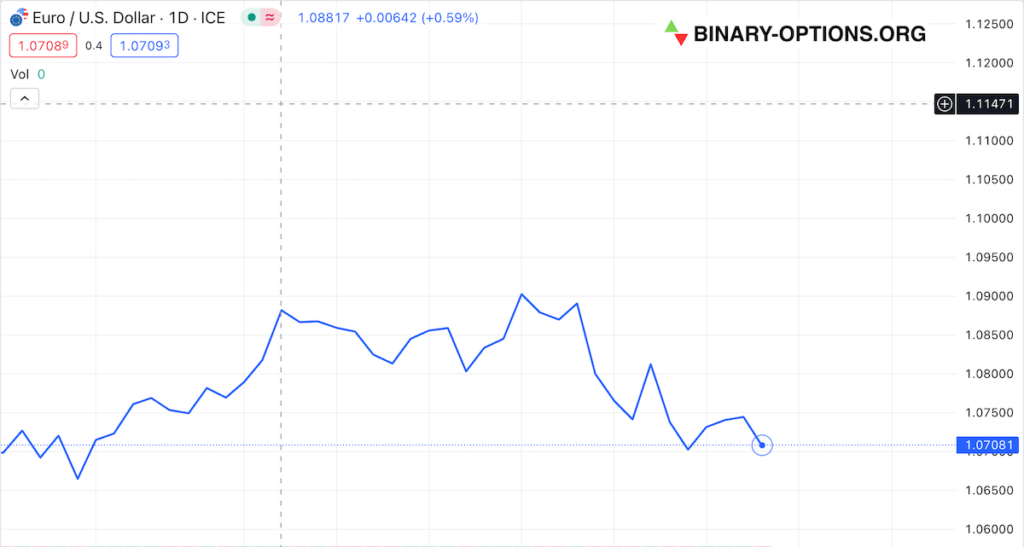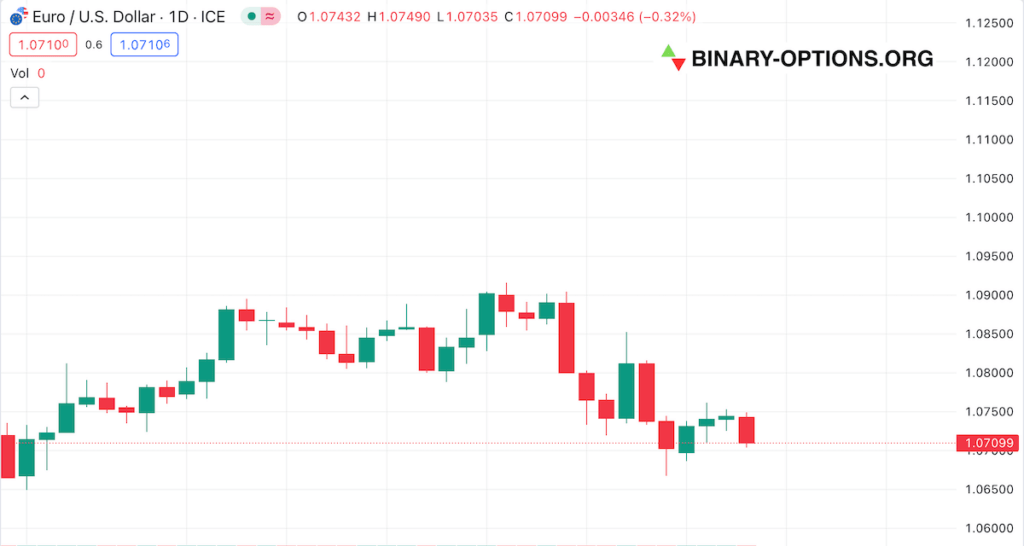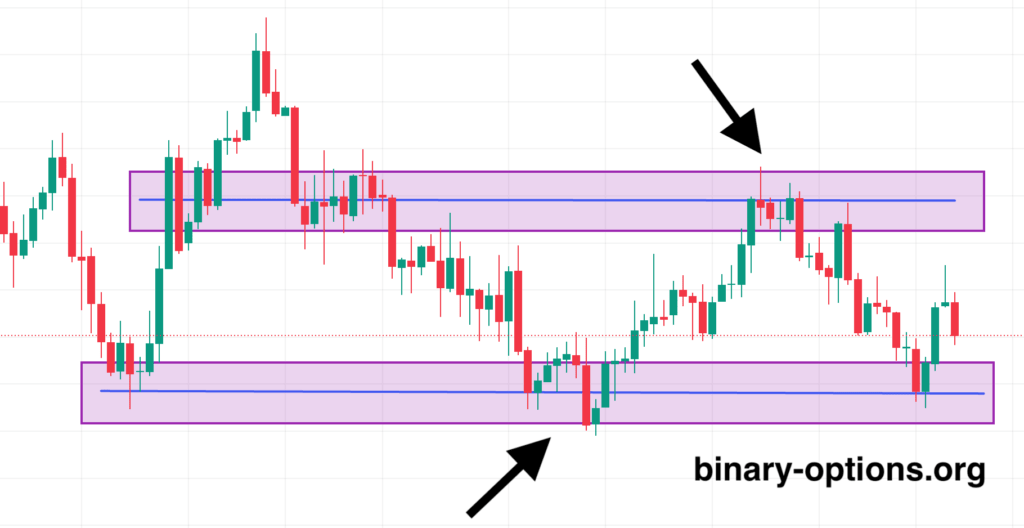Contents
Technical analysis plays a vital role in binary options trading by providing insights into price movements. It complements fundamental analysis, which focuses on economic factors, by utilizing historical price data and chart patterns to predict future trends with greater granularity. By mastering technical analysis components, traders can make more informed decisions and potentially improve their binary options trading outcomes.
Key Components of Technical Analysis
Technical analysis relies on several key elements to help traders interpret market behavior:
- Price Charts: The foundation for technical analysis, displaying price movements over time. These come in various forms:
- Line Charts: Focus on closing prices to identify long-term trends.
- Bar Charts: Show OHLC (Open, High, Low, Close) data for detailed price action analysis.
- Candlestick Charts: Combine OHLC with colored candles for visual representation of price movements and market sentiment.
- Heikin-Ashi Charts: A variation of candlestick charts that smooths price data to highlight trends.
- Technical Indicators: Mathematical calculations applied to price and volume data to generate signals for potential price movements. These can be categorized by function:
- Trend Indicators: Identify the overall direction of the market (uptrend, downtrend, sideways).
- Momentum Indicators: Measure the speed and strength of price movements.
- Volatility Indicators: Gauge the level of price fluctuation.
- Volume Indicators: Analyze trading activity to understand buying and selling pressure.
- Support and Resistance: Price levels where buying and selling pressure tend to converge, potentially causing the price to stall or reverse.
- Support: Areas where the price tends to find buying interest, potentially halting or reversing a downtrend.
- Resistance: Areas where the price tends to encounter selling pressure, potentially halting or reversing an uptrend.
- Chart Patterns: Recognizable formations on price charts that suggest potential future price movements. These patterns are based on historical observations of recurring market psychology. There are dozens of chart patterns, some common examples include:
- Continuation Patterns: Indicate a potential continuation of the current trend. (e.g., Head and Shoulders, Triangles)
- Reversal Patterns: Indicate a potential change in the current trend. (e.g., Double Top/Bottom, Hammer, Doji)
- Breakout Patterns: Suggest a potential break above resistance or below support. (e.g., Rising Wedge, Falling Wedge)
Price Charts: The Visual Storytellers
Line Charts: Ideal for identifying long-term trends by connecting the closing prices of an asset over a specified period. Advanced Tip: Utilize different moving averages overlaid on a line chart to gauge trend strength. This helps visualize how the average price moves in relation to the overall trend.

Bar Charts: Offer a more detailed view by displaying the open, high, low, and close (OHLC) prices for each time period. Analyze the size and color of the bars to understand price volatility and buying/selling pressure. Large bars with red bodies indicate strong selling pressure, while large bars with green bodies indicate strong buying pressure.

Candlestick Charts: Combine OHLC data with colored “candles” to depict bullish (green/white) or bearish (red/black) movements. These charts excel at showcasing price reversals and market sentiment at a glance. Advanced Tip: Master different candlestick patterns like hammer, engulfing, and doji to gain deeper insights. These patterns can signal potential trend reversals or continuations.

Heikin-Ashi: A variation of candlestick charts specifically designed to smooth out price movements and make trend identification easier. Heikin-Ashi achieves this by using averaged price data to calculate the open, high, low, and close of each bar. This filtering of market noise allows traders to focus on the underlying trend. Advanced Tip: While Heikin-Ashi charts excel at highlighting trends, they don’t directly reflect the exact opening, high, low, and closing prices of a single period. Therefore, they are less useful for analyzing specific price movements. To strengthen your analysis, consider combining Heikin-Ashi with other technical indicators for confirmation of signals.

Trends: Identifying the Direction
Trend Lines: Straight lines drawn on a chart to connect significant highs (resistance) or lows (support) over time. These help visualize the overall trend direction and strength. Advanced Tip: Employ trendline channels to identify potential breakout zones. A breakout above a rising trendline channel suggests a continuation of the uptrend, while a breakout below a falling trendline channel suggests a continuation of the downtrend.
Moving Averages (MAs): Smooth out price data by calculating the average price over a specific period. Popular MAs include Simple Moving Average (SMA) and Exponential Moving Average (EMA). Utilize them to confirm trends and identify potential reversal points. Shorter-term MAs react faster to price changes, while longer-term MAs provide a smoother representation of the overall trend. Advanced Tip: Combine different MAs with varying lengths to capture both short-term and long-term trends. This can help you identify potential entry and exit points for your binary options trades.

Technical Indicators: Mathematical Insights
Technical indicators are mathematical calculations based on price, volume, or open interest, providing additional signals for potential price movements. Here’s a closer look at some common indicators:
Moving Averages (MA) Crossover: As mentioned earlier, a short-term MA crossing above a long-term MA can indicate a potential buy signal for a binary option. Conversely, a crossover in the opposite direction might suggest a sell signal. Advanced Tip: Explore different MA lengths to find the combination that best suits your trading style and time frame. For example, for 60-second binary options, traders typically focus on indicators that react quickly to price changes. Consider using shorter-term moving averages like the Exponential Moving Average (EMA) with periods between 5 and 20, or the Moving Average Convergence Divergence (MACD) indicator to identify potential entry and exit points within the minute timeframe.
Relative Strength Index (RSI): Measures the speed and change of price movements to identify overbought or oversold conditions. An RSI above 70 might suggest a put option as the asset seems overbought, while an RSI below 30 might indicate a call option. Advanced Tip: Combine RSI with other indicators like stochastic oscillator for confirmation before placing a trade. This can help you avoid false signals and improve the accuracy of your trades.
Support and Resistance: The Price Battlegrounds
Support and resistance are critical price levels where buying and selling pressures clash, potentially reversing the price trend:
| Concept | Description | Advanced Tips |
|---|---|---|
| Support | A price point where buying interest is strong enough to prevent further declines, often causing prices to rebound. | Confirm support levels by analyzing trading volume. Higher volume during a price bounce indicates stronger support, making it less likely for the price to fall below this level. |
| Resistance | A price point where selling interest is strong enough to halt further increases, often causing prices to drop. | Detect potential breakouts above resistance by using candlestick patterns and volume spikes. A robust bullish candlestick pattern combined with high volume on a breakout indicates a higher probability of continued price increase. |

Support: A price level where buying interest is strong enough to prevent the price from falling further. It acts as a floor, with prices often bouncing back when they hit this level. Advanced Tip: Use volume analysis to confirm support levels. Higher volume on a bounce indicates stronger support, suggesting the price may be less likely to break below that level.
Resistance: A price level where selling interest is strong enough to prevent the price from rising further. It acts as a ceiling, with prices often falling back when reaching this level. Advanced Tip: Identify potential breakouts above resistance using candlestick patterns and volume surges. A strong bullish candlestick pattern accompanied by a surge in volume on a break above resistance suggests a higher likelihood of the price continuing to rise.
Chart Patterns: A Visual Language of Price Movements
Chart patterns are specific formations created by price movements, providing visual signals for future price trends. Here are a few key patterns to understand:
- Head and Shoulders: A reversal pattern indicating a potential shift from a bullish to a bearish trend. A break below the neckline (support level connecting the two shoulders) suggests a put option might be profitable. Advanced Tip: Ensure sufficient volume accompanies the neckline break for a stronger confirmation. High volume on the breakout suggests more conviction behind the price movement.
- Double Top/Bottom: These reversal patterns signal potential trend changes. A break below support in a double top or above resistance in a double bottom can signal a binary options trade based on the direction of the breakout. Advanced Tip: Look for additional confirmation from indicators like RSI before placing a trade based on these patterns. Combining chart patterns with technical indicators can help you increase your confidence in potential trades.
- Triangles (Ascending, Descending, Symmetrical): Continuation patterns suggesting the market will likely continue in the same direction after the pattern completes. A breakout above resistance in an ascending triangle suggests a call option, while a breakout below support in a descending triangle suggests a put option. Advanced Tip: These patterns can be tricky. Always practice identifying them on historical charts before using them in live trading. Develop a strong understanding of how these patterns form and behave in different market conditions.
Conducting Technical Analysis: A Step-by-Step Guide
Now that you have a solid foundation in the core components, here’s a step-by-step guide to conducting technical analysis for binary options trading:
- Select Asset & Time Frame: Choose the asset you want to trade and a time frame that suits your trading style (short-term, medium-term, long-term). Consider your risk tolerance and available capital when selecting a time frame.
- Analyze Price Charts: Identify trends, support and resistance levels using the various chart types discussed earlier. Look for potential entry and exit points based on these observations.
- Apply Technical Indicators: Add relevant technical indicators to your charts to gain insights into market momentum, overbought/oversold conditions, and potential trend reversals. Remember, indicators should complement your chart analysis, not replace it.
- Identify Chart Patterns: Look for chart patterns that align with your overall technical analysis and potentially signal profitable binary options trades.
- Formulate a Trading Plan: Develop a clear trading plan that outlines your entry and exit points, stop-loss levels, and profit targets. Risk management is crucial in binary options trading, and a well-defined plan helps you stay disciplined.
- Execute the Trade: Implement your trading plan by placing the appropriate call or put option based on your analysis.
- Monitor and Adjust: Continuously monitor the market and your trades. Be prepared to adjust your strategy based on new data and market conditions. Remember, the market is dynamic, and staying adaptable is key.
Conclusion
Technical analysis is essential in binary options trading. By mastering key components like price charts, trends, support and resistance, technical indicators, and chart patterns, traders can enhance their decision-making process and potentially improve their trading outcomes. However, remember that technical analysis is not a foolproof system. It should be combined with robust risk management practices for a well-rounded approach to navigating the complexities of the financial markets.
Further reading:
